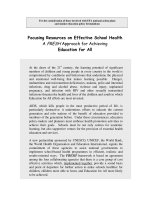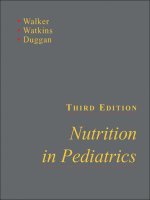BASIC SCIENCE FOR ANAESTHETISTS doc
Bạn đang xem bản rút gọn của tài liệu. Xem và tải ngay bản đầy đủ của tài liệu tại đây (2.83 MB, 224 trang )
BASIC SCIENCE FOR ANAESTHETISTS
This is a revised edition of a book originally titled Anaesthetic Data Interpretation. The
new title better reflects the contents of the book, which contains additional chapters rel-
evant to the Primary FRCA examination. New topics covered include the ventilatory
response to oxygen and carbon dioxide, which is now a core knowledge requirement,
new concepts in cardiovascular physiology, receptor types and the molecular actions
of anaesthetics. Some of the revisions reflect advances in technology; for example, the
uses of the capnograph and the oxygen analyser have advanced considerably in recent
years. The aim is to provide a concise and understandable review of the physics,
mathematics, statistics, physiology and pharmacology of anaesthesia. Basic Science for
Anaesthetists is a concise and informative text, which will be invaluable for trainee
anaesthetists and an aid to teaching for the trainers.
S
YLVA D OLENSKA qualified from Charles University, Prague, trained as an anaes-
thetist in the UK and is currently Consultant Anaesthetist at William Harvey Hospital,
Ashford, Kent. She has also acquired the KSS Deanery Certificate in Teaching. Her
other key professional interests are airway management and obstetric anaesthesia.
BASIC SCIENCE FOR
ANAESTHETISTS
BY
SYLVA DOLENSKA MD LMSSA FRCA
Consultant Anaesthetist, Department of Anaesthetics,
The William Harvey Hospital, Ashford, Kent, UK
CAMBRIDGE UNIVERSITY PRESS
Cambridge, New York, Melbourne, Madrid, Cape Town, Singapore, São Paulo
Cambridge University Press
The Edinburgh Building, Cambridge CB2 8RU, UK
First published in print format
ISBN-13 978-0-521-67602-1
ISBN-13 978-0-511-16895-6
© Cambridge University Press 2006
Every effort has been made in preparing this publication to provide accurate and up-to-
date information which is in accord with accepted standards and practice at the time of
publication. Although case histories are drawn from actual cases, every effort has been
made to disguise the identities of the individuals involved. Nevertheless, the authors,
editors and publishers can make no warranties that the information contained herein is
totally free from error, not least because clinical standards are constantly changing through
research and regulation. The authors, editors and publishers therefore disclaim all liability
for direct or consequential damages resulting from the use of material contained in this
publication. Readers are strongly advised to pay careful attention to information provided
by the manufacturer of any drugs or equipment that they plan to use.
2006
Information on this title: www.cambridge.org/9780521676021
This publication is in copyright. Subject to statutory exception and to the provision of
relevant collective licensing agreements, no reproduction of any part may take place
without the written
p
ermission of Cambrid
g
e University Press.
ISBN-10 0-511-16895-0
ISBN-10 0-521-67602-9
Cambridge University Press has no responsibility for the persistence or accuracy of urls
for external or third-party internet websites referred to in this publication, and does not
g
uarantee that any content on such websites is, or will remain, accurate or a
pp
ro
p
riate.
Published in the United States of America by Cambridge University Press, New York
www.cambridge.org
paperback
eBook (NetLibrary)
eBook (NetLibrary)
paperback
To my husband
CONTENTS
List of abbreviations and symbols page xi
List of figure captions xiii
Forewords xvii
Preface xxi
Preface to the second edition xxiii
Part 1: Physics, mathematics, statistics, anaesthetic
apparatus 1
1. Gas compression, relationship of volume, pressure
and temperature
2
2. Real gas compression 4
3. Flow and resistance 8
4. Heat, vaporization and humidification 14
5. Simple mechanics 1: mass, force, pressure 18
6. Simple mechanics 2: work and power 22
7. Mathematical concepts 26
8. Exponentials 1: the curves 30
9. Exponentials 2: properties of exponential decay curve 36
10. Descriptive statistics 40
11. Presentation of data 44
12. Receiver operating characteristic curve 48
13. Gas supply and pressure 52
14. The circle system 54
15. The Mapleson A (Magill) breathing system 58
16. T-pieces 60
17. Lung filling with automatic lung ventilators 62
Part 2: Clinical measurement 67
1. Basic measurement concepts
68
2. Electromanometers, frequency response and
damping
72
3. Pulse oximeter principle 76
vii
Contents
4. Oxygen content and oxygen tension measurement 80
5. Capnography 86
6. [H+], pH and its measurement 92
7. Principles of measurement of volume and flow in
gases and liquids
96
8. Cardiac output measurement by thermal dilution
technique
100
9. Measurement of the mechanical properties of the
chest
102
10. Lung volumes and their measurement 104
Part 3a: Physiology: the cardiovascular system 109
1. The cardiac cycle and the intravascular pressure
waveforms
110
2. Cardiovascular effects of intermittent positive
pressure ventilation
114
3. Control of cardiac output, regulation of cardiac
function
116
4. Cardiac cycle: pressure-volume relationships 118
5. Blood pressure and blood volume relationship 122
6. Cerebral blood flow 124
7. Coronary circulation 128
Part 3b: Physiology: the respiratory system 133
1. Oxyhaemoglobin dissociation curve
134
2. Respiratory mechanics 1: Static properties, factors
affecting compliance, closing volume
136
3. Respiratory mechanics 2: Dynamic properties,
factors affecting resistance
142
4. Ventilation–perfusion relationship 146
5. Oxygen cascade, oxygen therapy and shunt fraction 152
6. Gas R line, solution of the ventilation/perfusion
model
156
7. Ventilatory response to oxygen 160
8. Ventilatory response to carbon dioxide 162
viii
Contents
Part 4: Pharmacology 165
1. Drug elimination
166
2. Uptake and distribution of inhalational anaesthetic
agents
170
3. Pharmacodynamic effects of drugs 174
4. Minimum alveolar concentration and lipid solubility 180
5. Receptor types, molecular action of anaesthetics 182
6. Context sensitive half-time 186
Index 191
ix
ABBREVIATIONS and SYMBOLS
Units are shown in parentheses
a acceleration (m s
−2
)
A ampere
A area (m
2
)
c concentration (g l
−1
)
C compliance (l Pa
−1
)
C coulomb
Cd candela
◦
C degrees Celsius
d distance (m)
d rate of change (derivation)
D diameter (m)
e base of natural logarithms
E extinction coefficient
F force (kg m per s = N)
g gram
I light or current intensity (Cd or A)
J joule
K or k constant
K kelvin
l length (m)
l litre
m metre
mol amount of substance that contains as many elementary particles as
there are atoms in 0.012 kg carbon-12
n number
N newton
P power (J s
-1
= W)
p pressure (P
a
); see chapter on gas pipeline pressure for other units
and their conversion
Pa pascal
Q electric charge (C)
˙
Q flow (l s
-1
) (also denoted as dV/dt)
r radius (m)
R resistance (Pa l
-1
per s)
R universal gas constant
Re Reynolds’ number (dimensionless)
STP standard temperature and pressure (0
◦
C, 1 atmosphere = 273 K,
101.3 kPa)
t time (s)
xi
List of abbreviations and symblos
T absolute temperature (K)
v velocity (m s
-1
)
V volume (1)
W watt
W work (kg m
2
)
Greek symbols
(eta) viscosity
(mu) population mean
(pi) 3.141592653 . . .
(ro) density
(sigma) population standard deviation (SD)
(capital sigma) summa = total
(tau) time constant
(zeta) damping
xii
FIGURE CAPTIONS
Part 1
1. Three gas laws: Boyle’s, Charles’ and Gay-Lussac. page 3
2. Avogadro’shypothesis. 3
3. Isothermic compression. 5
4. Adiabatic decompression. 7
5. Laminar flow as the product of area and velocity. The influence of
doubling the radius on flow. 9
6. Laminar flow–pressure relationship. 11
7. Laminar flow–resistance relationship. 11
8. Turbulent flow–driving pressure relationship. 13
9. Turbulent flow–resistance relationship. 13
10. Latent heat of vaporization of water. 15
11. Latent heat of vaporization of nitrous oxide. 15
12. Water vapour content (absolute humidity) of air fully saturated
with water, as a function of temperature. 17
13. Force as a product of pressure and area. 19
14. Pressure generated in different size syringes with constant force. 19
15. Pressure-reducing valve. 21
16. Work as the product of force and distance. 23
17. Work (energy) as the product of pressure and volume. 23
18. Power as a derivative of work; cardiac power at two levels of
inotropy. 25
19. Cardiac power as a product of force and velocity. 25
20. Cardiac power as a product of pressure and flow. 25
21. Linear relationship. 27
22. Reciprocal relationship – the rectangular hyperbola. 27
23. Square function – parabola. 29
24. Sine waves and their addition. 29
25. Exponentials: (a) exponential growth curve. (b) growth of bacteria
with time. 31
26. Exponentials: (a) exponential decay curve. (b) exponential decline
plasma remifentanil concentration. 31
27. Exponentials: (a) saturation exponential curve.
(b) lung filling with a constant pressure generator. 33
28. Logarithmic curve and exponential growth curve. 33
29. Exponentials: rate of decay, time constant. 37
30. Area under the exponential curve. 39
31. Normal distribution of height in adult men. 41
32. Gaussian distribution – blood glucose measurements in a large
normal sample. 41
xiii
List of figure captions
33. Positive skew – distribution of hydrogen ion concentration in
humans. 43
34. Negative skew – distribution of haemoglobin concentration in
women. 43
35. Bimodal distribution. 43
36. Pie diagram. 45
37. Histogram (bar diagram). 45
38. Frequency histogram. 45
39. Scatter diagram: correlation coefficient = 1. 47
40. Scatter diagram: correlation coefficient = 0. 47
41. Line drawing with error bars. 47
42. Frequency distribution of fasting blood sugar in normal and
diabetic population. 49
43. ROC curves. 51
44. Pressure/volume relationship in medical gas supply. 53
45. The circle system. 55
46. The effect of nitrous oxide uptake and fresh gas flow in the circle
system on alveolar oxygen concentration. 55
47. Uptake of volatile anaesthetics as a function of time. 57
48. The Mapleson A breathing system. 59
49. Hypothetical pressure and expiratory flow in the Mapleson A
system. 59
50. T pieces. 61
51. Inspiratory flow and fresh gas flow in the Bain system. 61
52. Lung filling with a constant pressure generator. 63
53. Lung filling with a constant flow generator. 65
Part 2
54. Linearity principle: (a) Measurement accurate but imprecise.
(b) measurement precise but inaccurate. 69
55. Drift: (a) baseline (zero) drift, (b) sensitivity drift. 69
56. Hysteresis loop. 69
57. Critical damping. 71
58. Electromanometer principle. 73
59. Low damping. 75
60. High damping. 75
61. Optimal damping. 75
62. Extinction coefficients of reduced haemoglobins, in red and
infra-red light. 77
63. Relationship between saturation of arterial blood with oxygen and
the light absorbances ratio of haemoglobin. 77
64. Components of the pulse oximeter waveform. 79
65. Oxygen measurement: van Slyke apparatus. 81
66. Oxygen measurement: (a) fuel cell, (b) Clarke electrode. 83
67. Paramagnetic oxygen analyser. 83
68. Quadrupole mass spectrometer. 85
xiv
List of figure captions
69. Principal components of a capnograph. 87
70. Single breath analysis of expired CO
2
.87
71. Abnormalities of single breath curve. (a) chronic obstructive
airways disease. (b) cardiogenic oscillations. (c) dip in plateau.
(d) rebreathing. 89
72. Hypercapnia: (a) carbon dioxide overproduction or absorption
(b) rebreathing. 91
73. Hypocapnia: (a)overventilation, (b) collapse, (c) disconnection. 91
74. [H
+
] – pH relationship on a linear and logarithmic scale. 93
75. The pH electrode. 95
76. Flow measurement; relationship between flow and resistance for
constant pressure. 97
77. Linear relationship between driving pressure and flow. 97
78. Flow as a derivative of volume with respect to time. 99
79. Area under the line of flow. 99
80. Decreasing flow. 99
81. Cardiac output measurement. 101
82. Pressure changes in constant volume plethysmograph. 103
83. Lung volumes. 105
84. Measurement of functional residual capacity (FRC) by helium
wash-in method. 105
85. Measurement of functional residual capacity (FRC) by nitrogen
washout. 107
86. Single breath nitrogen washout. 107
Part 3a
87. Intravascular pressure waveforms on the right side of the heart
during pulmonary artery catheterization. 111
88. Arterial blood pressure and respiratory swing. 113
89. Arterial blood pressure and pulse during the Valsalva manoeuvre. 115
90. Frank–Starling curves. 117
91. Left ventricular and diastolic pressure–volume relationship. 119
92. (a) Left ventricular pressure–volume loop at steady state;
(b) The effect of increased inotropy on left ventricular
pressure–volume loop. (c) The effect of left ventricular failure
(reduced inotropy) on left ventricular pressure–volume loop. 121
93. Classes of haemorrhage. 123
94. Cerebrovascular autoregulation. 125
95. Cerebral elastance curve. 125
96. Autoregulation of cerebral blood flow within physiological limits. 127
97. Cerebral blood flow as a function of arterial carbon dioxide tension
(paCO
2
) and oxygen tension (paO
2
). 127
98. Coronary artery flow and arterial blood pressure. 129
99. Coronary autoregulation. 129
100. Effect of inhalational anaesthesia with halothane on coronary blood
flow and myocardial oxygen consumption. 131
xv
List of figure captions
Part 3b
101. Oxyhaemoglobin dissociation curve. 135
102. Respiratory mechanics. (a) resting position, (b) pressure gradients
after a tidal breath. 137
103. Static compliance. 137
104. The effect of age on lung and chest wall compliance. 139
105. Changes in closing volume (CV) and functional residual capacity
(FRC) during adulthood. 141
106. Size of airway and total cross-sectional area. 143
107. Airway resistance and age. 143
108. Dynamic compliance loops during spontaneous respiration. 145
109. Lung pressure–volume diagram in a young, healthy adult. 147
110. Alveolar volume in relation to distance from lung apex. 147
111. Diagram of the West zones of the lung. 149
112. Schematic drawing of ventilation–perfusion relationship in the
three zones of the lung. 151
113. The oxygen cascade. 153
114. The effect of shunt function and inspired oxygen fraction
(fio
2
) on arterial oxygen (P
a
O
2
). 155
115. Gas R line. 157
116. Ventilatory response to oxygen. 161
117. Ventilatory response to carbon dioxide. 163
Part 4
118. First-order kinetics of remifentanil and alfentanil. 167
119. Zero order and first order elimination of blood alcohol. 167
120. Biexponential decline in plasma concentration of a drug after
intravenous injection in a two-compartment model. 169
121. Factors influencing alveolar gas or vapour concentration during
uptake. 171
122. Rate of rise of alveolar concentration for different anaesthetic
agents. 173
123. Drug dose and effect. 175
124. Opioid drugs log dose–response curves. 177
125. Competitive and non-competitive antagonism of norepinephrine. 179
126. ED
50
,LD
50
. 179
127. MAC and lipid solubility of volatile agents in 100% oxygen and in
66% nitrous oxide. 181
128. Multisubunit ligand-gated ion channel. 183
129. G-protein coupled receptor. 183
130. Receptor as enzyme. 185
131. Drug levels in three compartments after a short infusion. 187
132. Drug levels in three compartments after a prolonged infusion. 187
133. Plasma alfentanil concentration after short and long infusion. 189
134. Context-sensitive half-time after short infusion. 189
135. Context-sensitive half-time after prolonged infusion. 189
xvi
FOREWORD
The syllabus for the Primary FRCA examination is broad, covering basic
anaesthesia and associated skills together with an in depth knowledge of the
principles of basic science which underlie clinical practice. Added to this,
is the requirement to pass the examination at an early stage of the trainee’s
career. Often, it is an inadequate understanding or wariness of concepts which
involve physics or simple mathematics that is the impediment to success in
the examination.
The author has written a book which explains the principles of physics,
mathematics and statistics and applies many of them to an understanding of
anaesthetic apparatus, clinical measurement, cardiovascular and respiratory
physiology, and general pharmacology. Each concept is supported by a graph
or diagram which is explained in the text. A graphical display of data or a
good diagram is often the key to interpretation and conveying a thorough
understanding of subject matter to an examiner. This approach applies equally
when responding to a question in an oral examination or when supplementing
a written answer.
This book is undoubtedly aimed at the candidate sitting the Primary exam-
ination, however, the Final FRCA candidate should not forget that the theme
of questioning in the second oral examination is basic science applied to anaes-
thesia, intensive care and pain management. This book should not be regarded
as a substitute for the standard textbooks but will be invaluable as a supple-
ment and also for revision. Senior colleagues will find in this book a concise
refresher course on basic science principles that will be of personal value and
will assist in teaching trainees. A proportion of candidates fail the oral section
of an examination having done well in the written part. This would suggest
they have the knowledge but fail in their verbal presentation. There is a fund
of questions, diagrams and graphs in this book that can form the basis of mock
vivas for candidates to improve their fluency of presentation in preparation
for the examination proper.
Leslie E. Shutt
Bristol
January 2000
xvii
FOREWORD
The successful and safe practice of anaesthesia depends, amongst other things,
upon a good comprehension of the scientific foundations of the subject. It is
for this reason that all examining boards set scientific questions in various parts
of their examinations, whether in conventional multiple choice or single best
answer format, formal essays, short answers, OSCEs (objective structured
clinical examinations) or in the oral examinations. Candidates have much
more difficulty with the basic and applied science sections of the examination
than with any other parts. In particular, the understanding of physics and the
application of physical principles are not easy. Many candidates, quite frankly,
lack basic education in these topics when starting at medical school; moreover,
they are less easy to learn as one grows older, especially when embarking on
a busy clinical career in anaesthesia.
I can remember from my own experiences as a candidate for the Primary
FRCA (then called the FFARCS) a legendary examiner who would push a
sheet of paper over to the unfortunate candidate during a viva and invite him or
her to draw the structure of pethidine (merperidine, Demerol). Thank good-
ness that does not happen nowadays, but reliance on the production of draw-
ings or graphs to illustrate a point is very common, for indeed a good picture is
worth a thousand (some say ten thousand) words. The interpretation of radio-
graphs and electrocardiograms has stood the test of time. Moreover, many
examiners now rely upon previously produced drawings or photographs -
of varying clarity and quality - as part of the examination, and I must confess
that I have produced some of my own over the years.
Sylva Dolenska originally intended to use the apt subtitle “do you get the
picture?” for this book but it was changed to Anaesthetic Data Interpretation and
the Primary FRCA examination became her target. Nevertheless, success
in any examination in anaesthesia, wherever in the world, relies upon the
grasp and understanding of basic scientific facts. Hence her approach of using
illustrations (linked to explanations) that have almost come straight from
the examiner’s briefcase provides welcome help for candidates. Examples are
drawn from everyday clinical anaesthesia: the use of medical gases, respira-
tory and circulatory physiology, the behaviour and distribution of drugs, and
concluding with concepts of receptors. Many current and future candidates
for examinations in anaesthesia should be grateful for the help this will give
them.
Anthony P. Adams
Professor of Anaesthetics in the University of London at the Guy’s, King’s and
St. Thomas’ School of Medicine, King’s College, London.
January 2000
xix









